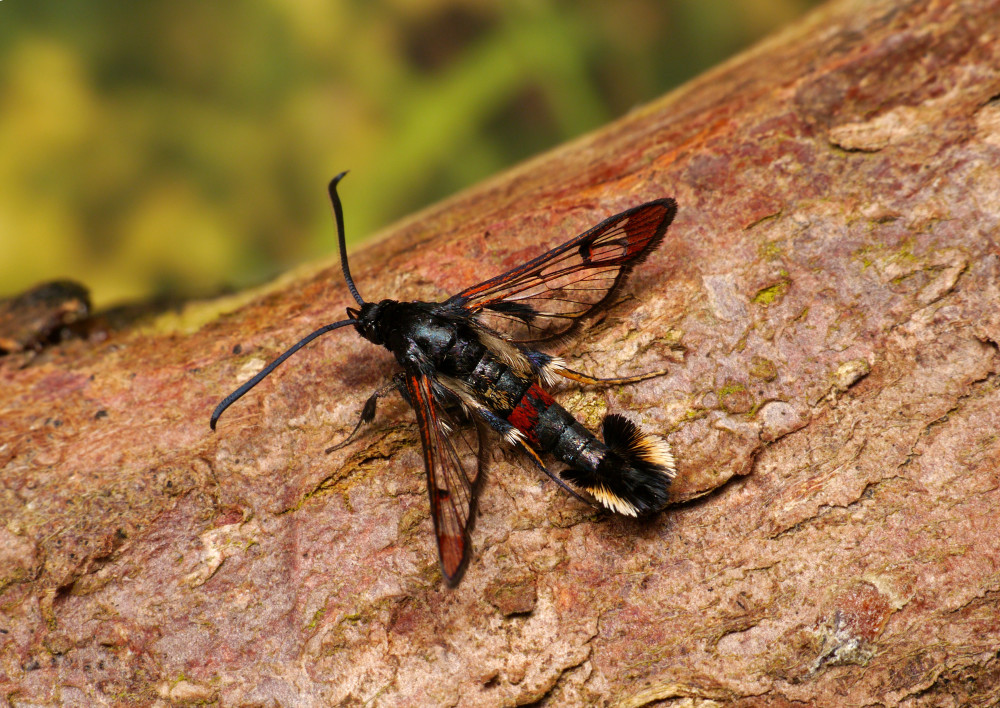Knowing about the biodiversity in your orchard is more than just interesting, what you discover can help tailor your orchard management to be sympathetic to the wildlife to which it is home. Your records may be important to the science and conservation of rare species.
Monitoring orchard wildlife can be easy and enjoyable and reveals much about habitat health. It is also a great way of teaching children about native UK wildlife.
Discovering the biodiversity in an orchard could be a big task and not one that you can achieve in one go. Perhaps think of an area you are particularly interested in and start recording them first, this could be birds, plants, fungi, moths or other insects. Doing surveys throughout the year will increase the amount of wildlife you discover.
Put a moth trap out over night, spend a sunny morning watching what birds fly, or take a closer look at the floor to discover the diversity of plants.
By keeping track of what you find, you will discover the secret life of orchard biodiversity and begin to understand the unique combination of species that call orchards home. Below are some ideas to get you started.
Jump to: Mammals | Plants | Invertebrates | Fungi | Birds
General orchard wildlife
Home to thousands of species, starting to work out what wildlife you have in your orchard can be a daunting prospect – where do you start? A great way to begin is to break the task into manageable chunks. This could be looking at a particular group of animals/plants or it could be looking at a particular place.
- + Square metre project
One place to start could be to mark out a patch of orchard and take a closer look to find out what lives just within this patch. Ecologist Patrick Roper has been doing just this in his garden for since 2003. He calls it his square metre project because that’s essentially all there is to it. He has a one metre square marked out at the bottom of his garden and records all life that he sees in it.
Astoundingly over the years he has seen and identified about 1,500 species! For inspiration here is his project blog about his findings in his metre.
Mammals
Most mammals are either nocturnal or active just at dusk and dawn. Some do make an appearance during the day, but usually early morning is the best time to see mammals.
It is is often easier to spot signs of mammals. Many, use regular runs, sometimes visible in the long grass and margins of orchards, or leave behind characteristic food remains, such as munched fruit or gnawed nuts.
Spotting wild mammals is difficult as they are more adept at detecting smells, sounds and movement than most of us, and are easily disturbed. For more than a fleeting glimpse, it is better to wait quietly for them to come to you.
More information can be found in our guide to spotting wild mammals and any sightings or signs you see in April, May and June can be entered in our Living with Mammals survey.
- + Hedgehogs
Hedgehogs are found in most parts of Britain, but are seeing a decline in population in the UK both in rural and urban environments. In the countryside, loss of hedgerows and permanent pastures as well as the widespread use of pesticides in food production has been linked to the decline of hedgehogs we are currently seeing.
Hedgehogs are woodland edge living species, suited to a mosaic habitat of hedges, fields and woodlands. If that sounds familiar, it’s because this is a fairly good way to describe traditional orchard habitat.
So how do you know whether you have resident or visiting hogs? Hedgehogs can be difficult to detect, being both nocturnal and inconspicuous. They come out of hibernation in April and are active until around October, so the summer months are your best bet at seeing hedgehogs out and about. Hedgehogs are most active in the few hours before midnight and can often be heard before they are spotted. It you are quiet, you might be lucky enough to hear them. They make a surprising amount of noise when eating, and make rummaging and snuffling sounds amongst vegetation.
Hedgehogs are generalist feeders and eat a range of things in the wild, but the majority of their diet is made up of invertebrates. Leaving food out for hedgehogs in the late summer might increase your chances of seeing any that live in your area, as this is a time of fattening up for hedgehogs in preparation for hibernation. If you do put food out for hedgehogs, try to mimic their natural diet. Good things to put out are meat-based dog or cat food or dried meal worms. Nearby hedgehogs should be able to sniff this out and might come over to feed and quiet observation of this food offering might give you a glimpse of all manner of wildlife even if you don’t spot a hedgehog.
If you are lucky enough to see hedgehogs don’t forget to map them on the big hedgehog map, which is helping us monitor populations across the UK.
- + Bats
If you are lucky, you might be visited or even inhabited by bats. These small flying mammals might be attracted for the roosting holes that veteran trees provide, or for the abundance of night flying insects that orchards host. The UK has 18 species of bat, but it is very difficult to tell them apart when they are flying quickly in the night sky.
Dusk in the summer months offers the best time to catch a glimpse of bats, where you might see them shooting through the dark sky. When out feeding, bats often follow set patterns or paths of flight, which might be loops or figures of eight. What this means is that if you see a bat fly by, it’s worth keeping an eye on that same patch of sky to see if they loop back round again. If you have a bat detector you can help differentiate the bat species by frequency of their echolocation calls. Although the ultrasound echolocation noises bats make are too high pitched for us to hear, the social noises they make are lower and can often be heard by children who’s ears are more sensitive to higher frequencies. So if you don’t have bat detector, employ the super-power bat-sense of a young person to help you discover orchard bat life.
Plants
It’s difficult to know where to start discovering the plants growing in an orchard. The hedge? In and on the fruit trees? The orchard floor? You might want to start with a particular group, like the grasses, or maybe simply with your favourites.
No matter where you start, you will need some way to identify the plants you are looking at. There are many guides to UK wildflowers available, but The Wild Flower Key: How to Identify Wild Plants, Trees and Shrubs in Britain and Ireland by Francis Rose comes recommended.
- + Mistletoe
Mistletoe is a fascinating plant. It is a ‘semi-parasitic’ plant that takes water and nutrients from its host tree, but makes its own food through photosynthesis. If left unchecked, mistletoe can swamp its host trees, causing damage especially in winter where its evergreen presence in a tree increases the chances of wind damage. However, healthy trees can easily support small quantities, which play an interesting and unique role in orchard ecosystem.
Mistletoe supports a mini-ecosystem of scarce invertebrates; one moth (mistletoe marble), one weevil and four bugs. The mistletoe weevil was only discovered in 2000 in Herefordshire, while the capsid bug is an even more recent discovery, found in Somerset in 2003.
- Although it is difficult to sample the biodiversity of mistletoe high up in a fruit tree, the characteristic yellow mine tunnels of the mistletoe larva can be seen if you have sharp eyes or a pair of binoculars. Or you could have a rummage through any mistletoe you remove from trees as part of sustainable management.
Find out more about mistletoe
- + Mosses
Because mosses can grow in places inhospitable to other plants they are good pioneer plants and can eventually allow the colonisation of vascular plants.
Mosses are a group of small flowerless plants that you can see all year round. They tend to like damp shady locations as they don’t have a developed water transport system or waterproofing to prevent the water from evaporating. Because they can absorb and store so much water they make great rainfall interceptors, helping stop rainfall simply draining out of the habitat straight away. They provide great micro-habitats for insects to live and take shelter.
- OPAL have created a great guide to mosses that you might expect to find in an orchard.
Invertebrates
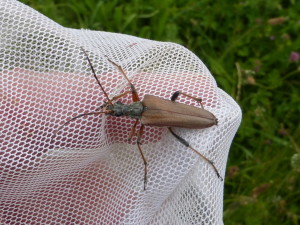
Longhorn by Tony Simpson
Traditional orchards are great for a variety of bugs, living everywhere from the canopy, bark and rot holes of trees, in old piles of wood rotting in the corner, on and under the ground as well as in bordering walls or hedges. If you look long enough at pretty much any part of an orchard you will find bugs of some description. As well as adding to the biodiversity and acting as an important food source for other species like birds and bats, bugs provide a variety of ecosystem services in your orchard such as eating decaying or dead wood, pollinating flowers and predating other bug species.
- + Methods for surveying invertebrates
There are many easy ways to discover orchard invertebrates, below are a few ideas of passive sampling to get you started. Always take care when sampling insects and release them afterwards.
- Manual searching. Yes, this is exactly as it sounds. A valuable and scientifically legitimate way of to study invertebrates is to literally just go out and look for them. Try searching under loose bark, in fallen decaying wood, in fallen fruit, on the ground below the grass layer and on flowers.
- Sweeping. Sweep nets can be swept over long grass to collect grassland invertebrates, or through the air to catch butterflies and other flying insects. A canvas or muslin bag open on the end of a stick is all you need to sample this way. Then look into the bag to see what you have collected, or empty the bag into a lidded container (like a large jam jar with tiny holes poked into the lid) if you want a closer look.
Caution: It is likely that you will collect stinging insects using this method, so take care when emptying the net, and try not to handle unidentified insects.
- Beating. This method allows you to get a better insight to the insect world in the tree canopy. Put a white sheet or a large upturned umbrella under a tree branch, and then shake the branch or hit it with a stick. This will dislodge some of the bugs from the branch which will fall out the tree onto the collecting sheet/umbrella, where you can either look at them directly, or collect them up later. Take care not to shake or beat the branch so hard that you risk damaging the tree.
Note: Please check first that there are no bird nests in the tree you are sampling. It is an offence to damage or destroy the nest of any wild bird whilst it is in use or being built.
- Pitfall trapping. A pitfall trap normally consists of a beaker or bottle that is buried in the ground so that the lip of the beaker is level with the ground surface. This set up catches insects that are active on the ground surface. Insects reaching the beaker fall in, and are often unable to climb back out. Leave the trap out for a day or so, then return to inspect the catch.
Buglife have produced a brilliant guide to help you narrow down what sort of mini-beast you are looking at.
- + Pollinating insects
Pollinators are an essential asset in an orchard. Without being pollinated your fruit trees will not set fruit. You might be surprised at the variety of insects that pollinate, it’s not all honeybees!
- The best way of discovering what pollinating insects are present is to go out and look at the flowers; your fruit tree blossom, and wildflowers in the grass, and in the hedges.
Here is a handy guide from Buglife about the broad classes of pollinating insects you might find.
- + Bumblebees
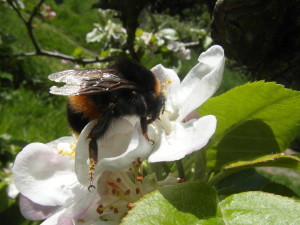 Of all the insects in an orchard bumblebees are one of the easiest to spot. You often hear them buzz before you see them, and are really valuable in orchards as their size means they can fly in colder, wetter and windier conditions than many other pollinators. This means that even when we have poor spring weather, with bumblebees in your orchard you will still get some sort of fruit crop. Bumblebee Conservation have made a guide to help identify the more common of the UK’s 24 bumblebee species.
Of all the insects in an orchard bumblebees are one of the easiest to spot. You often hear them buzz before you see them, and are really valuable in orchards as their size means they can fly in colder, wetter and windier conditions than many other pollinators. This means that even when we have poor spring weather, with bumblebees in your orchard you will still get some sort of fruit crop. Bumblebee Conservation have made a guide to help identify the more common of the UK’s 24 bumblebee species.
- + Butterflies and Moths
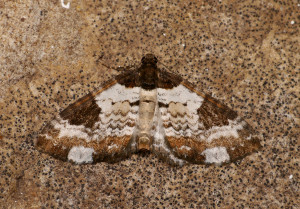 It turns out that there is no one rule that you can use to tell the difference between moths and butterflies. Moths can be just as big and beautifully colourful, many species fly during the day, both can eat nectar from flowers (amongst other things) and both moths and butterflies have powdery wings. The most reliable, but still not foolproof, way of telling the difference is looking at their antennae. Butterflies have thin antennae with small clubs at the end, whilst moth antennae do not have the clubbed ends and can vary widely in shape and size.
It turns out that there is no one rule that you can use to tell the difference between moths and butterflies. Moths can be just as big and beautifully colourful, many species fly during the day, both can eat nectar from flowers (amongst other things) and both moths and butterflies have powdery wings. The most reliable, but still not foolproof, way of telling the difference is looking at their antennae. Butterflies have thin antennae with small clubs at the end, whilst moth antennae do not have the clubbed ends and can vary widely in shape and size.
Moths
Moths are much more varied than butterflies and act as a really good indicator to the health of our environment. You might be surprised by the number and diversity you find when you start ‘mothing’.
- Light trapping. This can be as simple as a bright light and a white sheet. Set up a sheet with a bright light behind it. Moths will be attracted to the light, and settle on the sheet where you can look at them and take photos. Be patient, it might take a while for any moths to settle on your sheet and different moths come out at different times throughout the evening.
- Sugaring is a technique to attract moths to a specific location to be identified. Heat brown ale or cola and simmer for a few minutes, add a kilo of brown sugar and a tin of treacle. Let this cool and paint it on a tree trunk or post. Moths will be attracted to this and will settle to feed, giving you the chance to look at, photograph and identify them.
Note: Don’t pick moths up with your hands as they are very easily damaged and we want to make sure they are released unharmed at the end of the evening. Here is a brilliant introduction to ‘mothing’ by mothscount.org to get you started.
There are 59 species of butterfly in the UK, ever wondered how many your orchard is home to?
Butterflies
Butterflies are good indicators of biodiversity. They are a fragile group that is quick to respond to changes in the environment, so the relative stability of the orchard habitat suits them. You might find the orange tip or speckled wood butterflies, both of which are shade tolerant and like the dappled sunshine you find between fruit trees. Or the caterpillars of the peacock and small tortoiseshell, which both lay eggs on patches of nettle.
Take a photo of any you see and find out what it is using this identification tool from butterfly-conservation. Here is a great tool from London’s Natural History Museum to find out the different moth and butterfly caterpillar food-plants.
- + Beetles
Orchards are home to all sorts of beetle species living in the trees, the ground, the hedges and in deadwood habitats. Nature spot have a guide to beetles you might find in the UK.
Noble chafer
The noble chafer (Gnorimus nobilis) is one of UK’s rarest beetles. This metallic, bronze-green beetle is approximately 2 cm long and is associated with old orchards where it is dependent on decaying wood within live trees especially plum, apple and cherry. The larval stage of the noble chafer occurs entirely within the decaying trunks and branches where the larvae feed on the rotting wood debris. On emergence, in the summer months, the adult beetle can sometimes be found visiting flowers such as hogweed, meadowsweet and elder. Adult noble chafers emerge in early summer and live for about 4-6 weeks. The peak flight season is June and July. In the morning, after emerging from the tree, beetles will bask for a short while to warm up their flight muscles, then fly to feed on nearby flowers For more information and how to look for them see our noble chafer page.
Stag beetles
Stag beetles are the largest terrestrial beetle in the UK. Sadly they are globally threatened. Habitat loss and fragmentation have almost certainly contributed to the decline of this magnificent beetle. Stag beetles are reliant on dead wood for such a long period of their life cycle that the impacts of tidy gardens, parks and woodlands have been devastating. Stag beetles tend to be seen flying at dusk in the summer looking for a mate, and if you do see one please log it here, or for more information visit our stag beetle pages.
Cockchafers
Cockchafers are large flying beetles often known as Maybugs. They are easily recognisable by their feathery antennae, pointy abdomen and their size. Once a common species, cockchafer numbers went into serious decline in the mid 20th century through pesticide use. Although still fairly common in the west of Britain, cockchafers are only reliably found in orchard habitats in the east, mainly due to the loss of other suitable habitat. Cockchafers are an important food source for bats such as the greater horseshoe and noctule, who like eating the large cockchafers to put on weight before winter.
Fungi
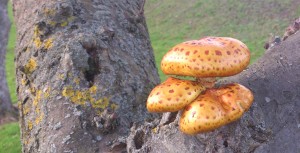
Pholiota aurivella in Bramley
Fungi play a vital role in a healthy ecosystem by breaking down dead plant and animal matter, and are part of a network of interactions between soils and plant roots called mycorrhizal associations. However, normally you only see the fruiting bodies, the toadstools, as the rest of the organism is hidden underground or within dead wood. Even the wild yeasts that orchard owners may routinely utilise in the process of brewing cider are members of the fungi kingdom.
Although some fungi have fruiting bodies around the year, the best displays are seen late summer and throughout autumn, where you might find fairy rings on the orchard floor or clusters on stumps and in trees.
- + Orchard tooth fungus

Orchard tooth fungus – Sarcodontia crocea
The orchard tooth fungus is very rare in the UK, found in fewer than 20 sites, normally on rotting branch ends or in rot holes on apple trees in the sun, between June and September. Like the noble chafer, this fungus only feeds on the dead heart wood, so is not a threat living trees. This fungus is distinctive by its smell of pineapple, changing to rotting fruit as it gets older.
- + Lichens
Lichens
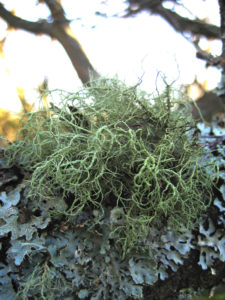
Usnea sp. and Parmelia sp. on an apple tree
Lichens are particularly fascinating, way more so than they appear at first glance. They consist of a fungi and photosynthetic partner (algae or bacteria) living together symbiotically. Most fruit trees have lichen on their bark and old trees can have many different species. In recent surveys 26 species of lichen occurred in just one orchard. Lichens are really good indicators of air quality as they are sensitive to pollution. This means that they can help us understand how our environment is changing.
- Naturespot have a guide to lichens to get you started on this fascinating group.
Birds
Traditional orchards provide a great habitat for birds, with nesting sites and food in plentiful supply.
Similar to watching for mammals, your best chance of observing the bird life in your orchard is to sit quietly in the morning and watch.
You might see nuthatches and tree creepers feeding on insects in the bark of your trees, blue tits gorging on codling moth larvae and other insects, woodpeckers nesting in rot holes or hunting ants in the grassland as well as fieldfares and redwings making the most of the fallen fruit in winter. You might see mistle thrushes or black caps feasting on mistletoe berries, blackbirds, finches, yellow hammers or owls throughout the year and even maybe sparrowhawks making the most of the abundant wildlife on the menu.
